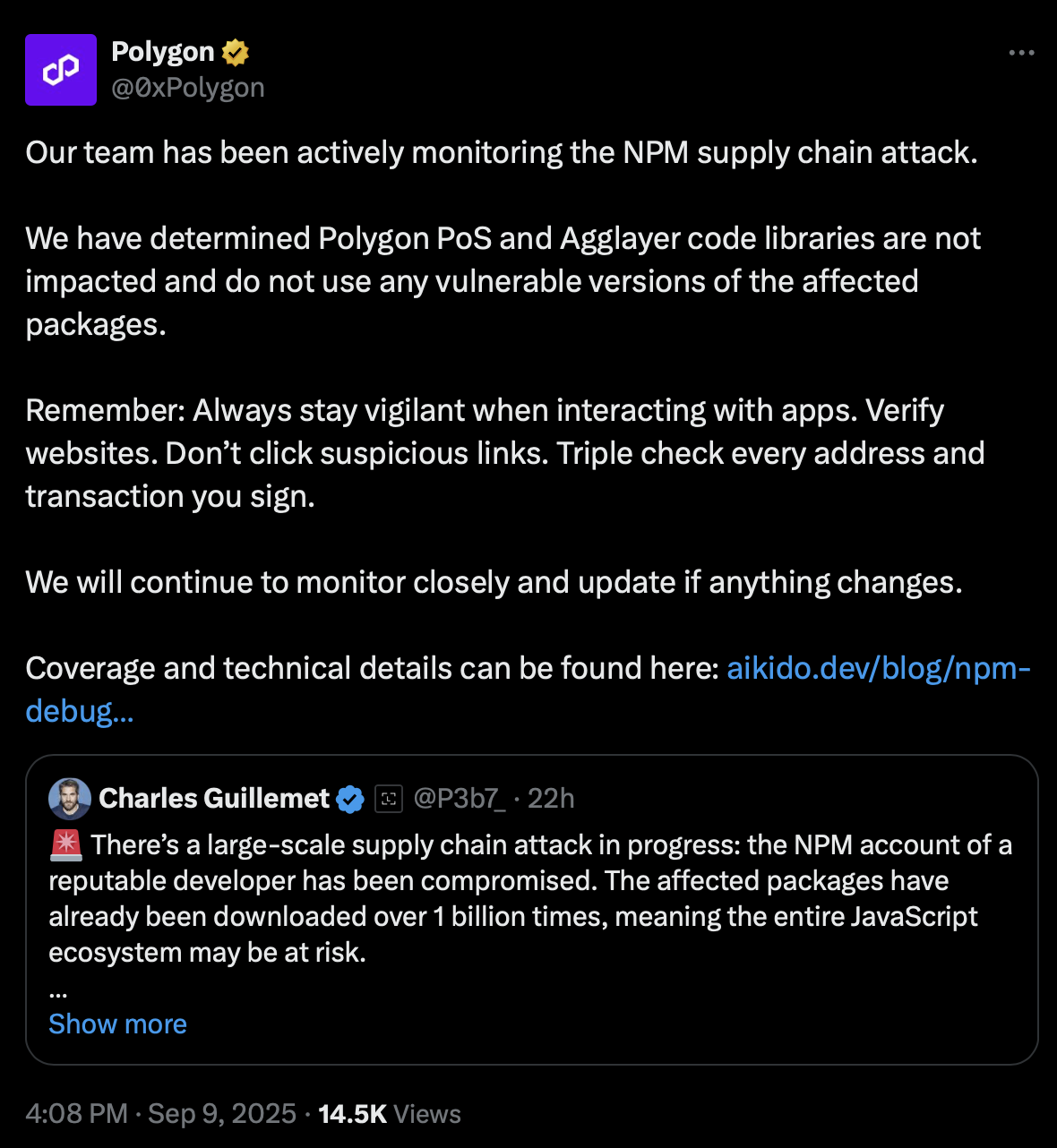| COINOTAG recommends • Exchange signup |
| 💹 Trade with pro tools |
| Fast execution, robust charts, clean risk controls. |
| 👉 Open account → |
| COINOTAG recommends • Exchange signup |
| 🚀 Smooth orders, clear control |
| Advanced order types and market depth in one view. |
| 👉 Create account → |
| COINOTAG recommends • Exchange signup |
| 📈 Clarity in volatile markets |
| Plan entries & exits, manage positions with discipline. |
| 👉 Sign up → |
| COINOTAG recommends • Exchange signup |
| ⚡ Speed, depth, reliability |
| Execute confidently when timing matters. |
| 👉 Open account → |
| COINOTAG recommends • Exchange signup |
| 🧭 A focused workflow for traders |
| Alerts, watchlists, and a repeatable process. |
| 👉 Get started → |
| COINOTAG recommends • Exchange signup |
| ✅ Data‑driven decisions |
| Focus on process—not noise. |
| 👉 Sign up → |
The Sept. 8 NPM hack injected clipper malware into tampered NPM packages, targeting crypto address fields. Major services say no funds were lost; developers and users should verify package integrity, avoid unverified dependencies, and confirm on-chain addresses before sending funds.
-
Polygon, Ledger, Trezor confirm systems unaffected
-
Largest JavaScript NPM supply-chain attack delivering clipper malware targeting crypto
-
Recommendation: verify dependencies, use hardware wallets, and double-check addresses before signing
NPM hack: immediate safety steps for crypto users—verify packages, use hardware wallets, confirm addresses on device. Learn what to do now.
What happened in the Sept. 8 NPM hack?
The Sept. 8 NPM hack saw a compromised developer account used to publish tampered NPM packages that contained clipper malware. These modified packages are designed to intercept and replace cryptocurrency addresses, redirecting funds to attackers without the sender’s knowledge.
| COINOTAG recommends • Professional traders group |
| 💎 Join a professional trading community |
| Work with senior traders, research‑backed setups, and risk‑first frameworks. |
| 👉 Join the group → |
| COINOTAG recommends • Professional traders group |
| 📊 Transparent performance, real process |
| Spot strategies with documented months of triple‑digit runs during strong trends; futures plans use defined R:R and sizing. |
| 👉 Get access → |
| COINOTAG recommends • Professional traders group |
| 🧭 Research → Plan → Execute |
| Daily levels, watchlists, and post‑trade reviews to build consistency. |
| 👉 Join now → |
| COINOTAG recommends • Professional traders group |
| 🛡️ Risk comes first |
| Sizing methods, invalidation rules, and R‑multiples baked into every plan. |
| 👉 Start today → |
| COINOTAG recommends • Professional traders group |
| 🧠 Learn the “why” behind each trade |
| Live breakdowns, playbooks, and framework‑first education. |
| 👉 Join the group → |
| COINOTAG recommends • Professional traders group |
| 🚀 Insider • APEX • INNER CIRCLE |
| Choose the depth you need—tools, coaching, and member rooms. |
| 👉 Explore tiers → |
Which major crypto teams reported no losses?
Official statements from project teams state that Polygon Proof-of-Stake and Agglayer are unaffected by the supply-chain incident. Hardware wallet providers Ledger and Trezor both announced that device firmware and core wallet protections remained secure. Ledger CTO Charles Guillemet communicated details of the discovery in official channels, emphasizing that Ledger devices protect private keys against such software-level attacks.

| COINOTAG recommends • Exchange signup |
| 📈 Clear interface, precise orders |
| Sharp entries & exits with actionable alerts. |
| 👉 Create free account → |
| COINOTAG recommends • Exchange signup |
| 🧠 Smarter tools. Better decisions. |
| Depth analytics and risk features in one view. |
| 👉 Sign up → |
| COINOTAG recommends • Exchange signup |
| 🎯 Take control of entries & exits |
| Set alerts, define stops, execute consistently. |
| 👉 Open account → |
| COINOTAG recommends • Exchange signup |
| 🛠️ From idea to execution |
| Turn setups into plans with practical order types. |
| 👉 Join now → |
| COINOTAG recommends • Exchange signup |
| 📋 Trade your plan |
| Watchlists and routing that support focus. |
| 👉 Get started → |
| COINOTAG recommends • Exchange signup |
| 📊 Precision without the noise |
| Data‑first workflows for active traders. |
| 👉 Sign up → |
How does clipper malware work and why is it dangerous?
Clipper malware monitors clipboard activity and replaces legitimate cryptocurrency addresses with attacker-controlled addresses at the moment a user pastes an address. Because transactions are irreversible on most blockchains, victims can lose funds instantly if they do not notice the mismatch before confirming the transaction.
How widespread is the risk from tampered NPM packages?
Altered NPM packages can be widely distributed: NPM is central to JavaScript development and packages may be downloaded millions to billions of times. A single compromised package used in popular projects or tooling can propagate to many developer environments and user-facing builds, increasing exposure.
| COINOTAG recommends • Traders club |
| ⚡ Futures with discipline |
| Defined R:R, pre‑set invalidation, execution checklists. |
| 👉 Join the club → |
| COINOTAG recommends • Traders club |
| 🎯 Spot strategies that compound |
| Momentum & accumulation frameworks managed with clear risk. |
| 👉 Get access → |
| COINOTAG recommends • Traders club |
| 🏛️ APEX tier for serious traders |
| Deep dives, analyst Q&A, and accountability sprints. |
| 👉 Explore APEX → |
| COINOTAG recommends • Traders club |
| 📈 Real‑time market structure |
| Key levels, liquidity zones, and actionable context. |
| 👉 Join now → |
| COINOTAG recommends • Traders club |
| 🔔 Smart alerts, not noise |
| Context‑rich notifications tied to plans and risk—never hype. |
| 👉 Get access → |
| COINOTAG recommends • Traders club |
| 🤝 Peer review & coaching |
| Hands‑on feedback that sharpens execution and risk control. |
| 👉 Join the club → |
What should developers and crypto users do now?
Follow these prioritized safety steps immediately:
- Audit recent dependency updates and revert suspicious changes.
- Verify package integrity via checksums or signatures where available.
- Use hardware wallets (Ledger, Trezor) to confirm on-device transaction details.
- Manually verify pasted addresses and enable address-book checks in wallets.
- Avoid installing packages from unverified sources or newly published packages without review.
Are hardware wallets safe against this attack?
Hardware wallets such as Ledger and Trezor protect private keys in isolated hardware and require on-device confirmation of transaction details. Both vendors stated their devices and official management apps were not compromised. However, users must still confirm addresses on-device to prevent clipper replacement attacks.
Frequently Asked Questions
Is my wallet or funds at risk right now?
If you use a hardware wallet and always confirm addresses on-device, your private keys remain protected. Software wallets can be at higher risk if clipper malware alters addresses. Always confirm addresses on hardware or trusted display devices.
| COINOTAG recommends • Exchange signup |
| 📈 Clear control for futures |
| Sizing, stops, and scenario planning tools. |
| 👉 Open futures account → |
| COINOTAG recommends • Exchange signup |
| 🧩 Structure your futures trades |
| Define entries & exits with advanced orders. |
| 👉 Sign up → |
| COINOTAG recommends • Exchange signup |
| 🛡️ Control volatility |
| Automate alerts and manage positions with discipline. |
| 👉 Get started → |
| COINOTAG recommends • Exchange signup |
| ⚙️ Execution you can rely on |
| Fast routing and meaningful depth insights. |
| 👉 Create account → |
| COINOTAG recommends • Exchange signup |
| 📒 Plan. Execute. Review. |
| Frameworks for consistent decision‑making. |
| 👉 Join now → |
| COINOTAG recommends • Exchange signup |
| 🧩 Choose clarity over complexity |
| Actionable, pro‑grade tools—no fluff. |
| 👉 Open account → |
How can developers check if an NPM package was tampered with?
Developers should check package checksums, audit the package source code, compare with upstream repositories, and validate author account activity. Revert suspicious upgrades and lock dependency versions until the ecosystem provides verified fixes.
Key Takeaways
- Immediate safety: Verify addresses on hardware wallets and avoid pasting addresses unless confirmed on-device.
- Developer action: Audit recent NPM dependency changes, use integrity checks, and freeze or pin known-good versions.
- Long-term: Strengthen supply-chain defenses, adopt signed packages, and follow vendor advisories from Ledger, Trezor, and relevant projects.
Conclusion
The Sept. 8 JavaScript NPM hack is a major supply-chain incident that inserted clipper malware into published packages. While Polygon, Ledger, and Trezor report no funds lost, the incident highlights systemic risks in the NPM ecosystem. Users and developers should adopt immediate verification steps and hardware confirmations to mitigate losses. Stay updated with official statements and security advisories from project teams and vendors.
| COINOTAG recommends • Members‑only research |
| 📌 Curated setups, clearly explained |
| Entry, invalidation, targets, and R:R defined before execution. |
| 👉 Get access → |
| COINOTAG recommends • Members‑only research |
| 🧠 Data‑led decision making |
| Technical + flow + context synthesized into actionable plans. |
| 👉 Join now → |
| COINOTAG recommends • Members‑only research |
| 🧱 Consistency over hype |
| Repeatable rules, realistic expectations, and a calmer mindset. |
| 👉 Get access → |
| COINOTAG recommends • Members‑only research |
| 🕒 Patience is an edge |
| Wait for confirmation and manage risk with checklists. |
| 👉 Join now → |
| COINOTAG recommends • Members‑only research |
| 💼 Professional mentorship |
| Guidance from seasoned traders and structured feedback loops. |
| 👉 Get access → |
| COINOTAG recommends • Members‑only research |
| 🧮 Track • Review • Improve |
| Documented PnL tracking and post‑mortems to accelerate learning. |
| 👉 Join now → |
| COINOTAG recommends • Exchange signup |
| 🎯 Focus on process over noise |
| Plan trades, size positions, execute consistently. |
| 👉 Sign up → |
| COINOTAG recommends • Exchange signup |
| 🛠️ Simplify execution |
| Keep decisions clear with practical controls. |
| 👉 Get started → |
| COINOTAG recommends • Exchange signup |
| 📊 Make data your edge |
| Use depth and alerts to avoid guesswork. |
| 👉 Open account → |
| COINOTAG recommends • Exchange signup |
| 🧭 Be prepared, not reactive |
| Turn setups into rules before you trade. |
| 👉 Create account → |
| COINOTAG recommends • Exchange signup |
| ✍️ Plan first, then act |
| Entries, exits, and reviews that fit your routine. |
| 👉 Join now → |
| COINOTAG recommends • Exchange signup |
| 🧩 Consistency beats intensity |
| Small, repeatable steps win the long run. |
| 👉 Sign up → |
| COINOTAG recommends • Members‑only research |
| 📌 Curated setups, clearly explained |
| Entry, invalidation, targets, and R:R defined before execution. |
| 👉 Get access → |
| COINOTAG recommends • Members‑only research |
| 🧠 Data‑led decision making |
| Technical + flow + context synthesized into actionable plans. |
| 👉 Join now → |
| COINOTAG recommends • Members‑only research |
| 🧱 Consistency over hype |
| Repeatable rules, realistic expectations, and a calmer mindset. |
| 👉 Get access → |
| COINOTAG recommends • Members‑only research |
| 🕒 Patience is an edge |
| Wait for confirmation and manage risk with checklists. |
| 👉 Join now → |
| COINOTAG recommends • Members‑only research |
| 💼 Professional mentorship |
| Guidance from seasoned traders and structured feedback loops. |
| 👉 Get access → |
| COINOTAG recommends • Members‑only research |
| 🧮 Track • Review • Improve |
| Documented PnL tracking and post‑mortems to accelerate learning. |
| 👉 Join now → |








